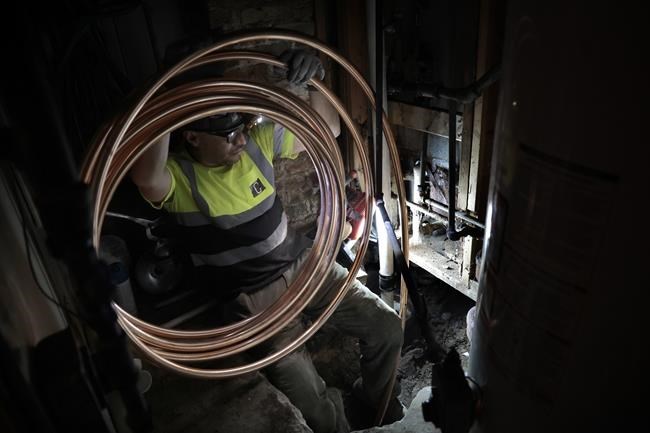
A laborer holds onto a coiled copper pipe as it is pulled from the home, under the ground and out to the street for connection to the water main during lead service replacement on April 10, 2023, in Chicago. Lead pipes that carry drinking water are a major source of exposure to the metal and the damage is usually permanent. (Antonio Perez/Chicago Tribune via AP)
Republished July 09, 2023 - 7:50 AM
Original Publication Date July 08, 2023 - 9:41 PM
Even though lead in drinking water damages children's development, the Environmental Protection Agency has forced very few cities to replace their lead pipes.
Consider Chicago, with more water pipes made out of lead than any U.S. city, some 400,000. About 7% of homes that requested sampling last year exceeded federal limits, and in at least 73 homes, it was at least twice that much, according to an AP analysis of more than 3,500 samples collected using a method that’s more sensitive than the federal government's.
Yet that many homes was never enough to trigger the mandate to remove pipes.
That's because EPA standards only say most homes – not all – can’t have dangerous amounts of lead.
Since Chicago was never forced to remove its lead pipe, it left most of it in the ground, relying on water treatment instead to lower the lead levels.
State and local officials say they had limited funds that needed to be used elsewhere. They also say local rules made removal work more difficult and more expensive.
WATER MAIN WORK
In 2012, the city began rapidly replacing its aged water mains. These are typically made of cast-iron, not lead. When road crews came across the lead pipes that branch off and serve individual homes, they only replaced a short piece near the water main with copper. Thousands and thousands of times, they reburied the junction and left the rest.
Just as the city was wrapping up that effort, the Illinois legislature made that method illegal.
Miguel Del Toral, a former EPA regulations manager who was also a whistleblower on the Flint, Michigan lead pipe disaster, said Chicago ignored the toxic effects of lead in drinking water.
“During the water main replacement program, there was no acknowledgement that there was an issue,” he said.
Del Toral was not the only one to object to the city's actions. Two Chicago residents filed a proposed class action in 2017, arguing Chicago’s water main work increased people's risk of lead exposure. They cited studies that said disturbing lead pipe and then leaving it in the ground can actually spike levels in tap water.
The next year, to protect against those spikes, the city finally started handing out water filters to residents in neighborhoods where public works crews were replacing mains. The lawsuit was eventually dismissed.
CHICAGO’S OFFICIAL VIEW
The EPA has said replacing lead pipes during water main work is not only safer, it is also about 20% cheaper. But Chicago Commissioner of Water Management Andrea Cheng said that's not true in Chicago. State rules there required expensive construction methods until last year. Only recently did the city start waiving permit fees that can add thousands of dollars to lead replacement costs, she said.
Cheng said old water mains can rupture, and slowing their replacement by dealing with all the lead pipes would have been irresponsible and could expose people to bacteria. She said Chicagoans face a bigger threat of poisoning from lead paint and the city is trying to fight that.
The city of Detroit found success when it pressured residents to let road crews onto private property to remove lead pipes. Rules like that are not in place in Chicago.
“Do you know how many people want their yard dug up?” Cheng said. “Not many.”
Since the legislature changed the law, most residents have allowed workers on their property to replace pipes, she said.
Today, Chicago offers a limited, free lead pipe replacement program for low-income households and daycares and recently started replacing lead pipes when they break — a common occurrence in a city with harsh winters. But the city says it will take decades to replace all of them. Residents will continue to be exposed.
So three decades after the federal government imposed lead limits for drinking water, the vast majority of lead pipe is still in the ground not only in Chicago, but across the country.
Marc Edwards, a water treatment specialist at Virginia Tech, said proactive cities that replaced entire lenths of lead pipe are in better shape.
“You’re solving the problem once and for all," he said. "It’s much more cost effective to do it all at one time than to just leave that problem for the homeowner to forget about and realize in 30 years that their kids have been lead poisoned.”
___
Fassett reported from Seattle.
___
The Associated Press receives support from the Walton Family Foundation for coverage of water and environmental policy. The AP is solely responsible for all content. For all of AP’s environmental coverage, visit https://apnews.com/hub/climate-and-environment
News from © The Associated Press, 2023